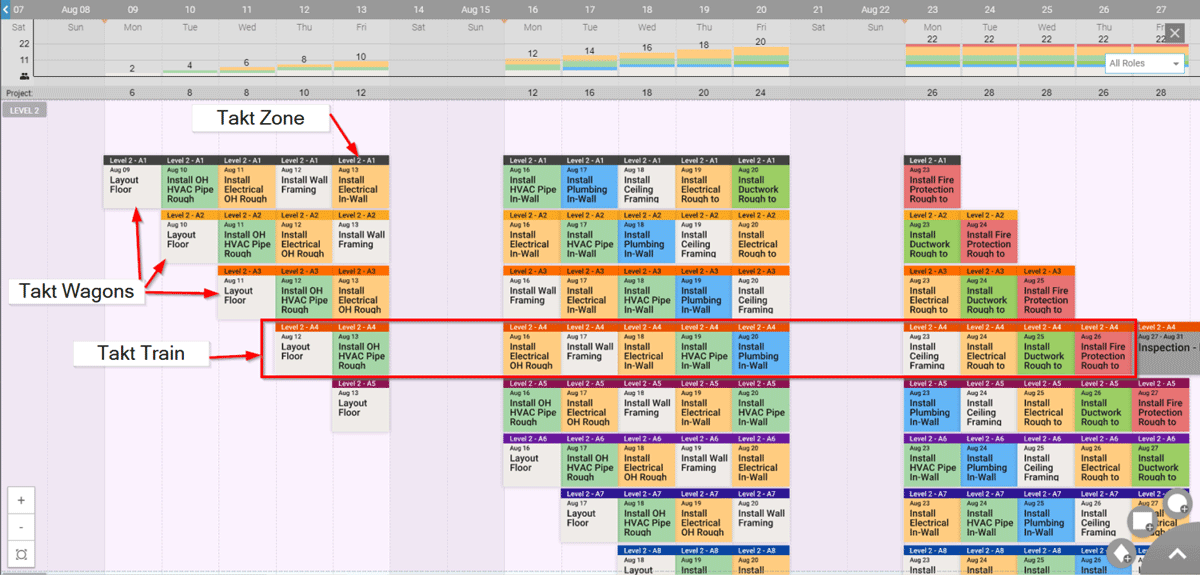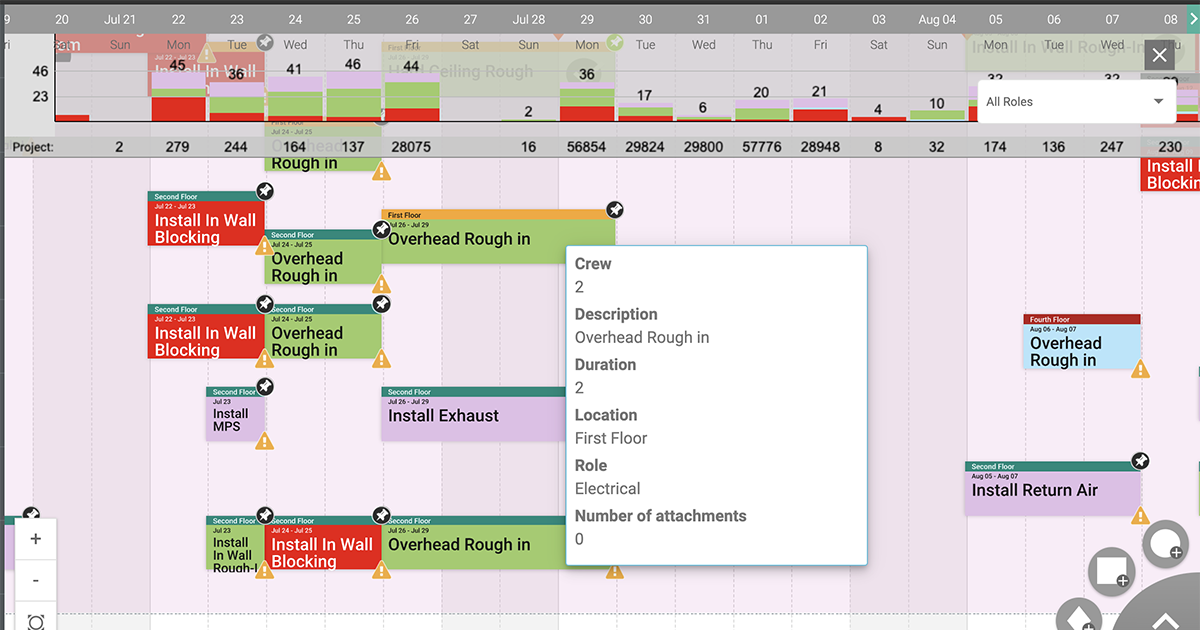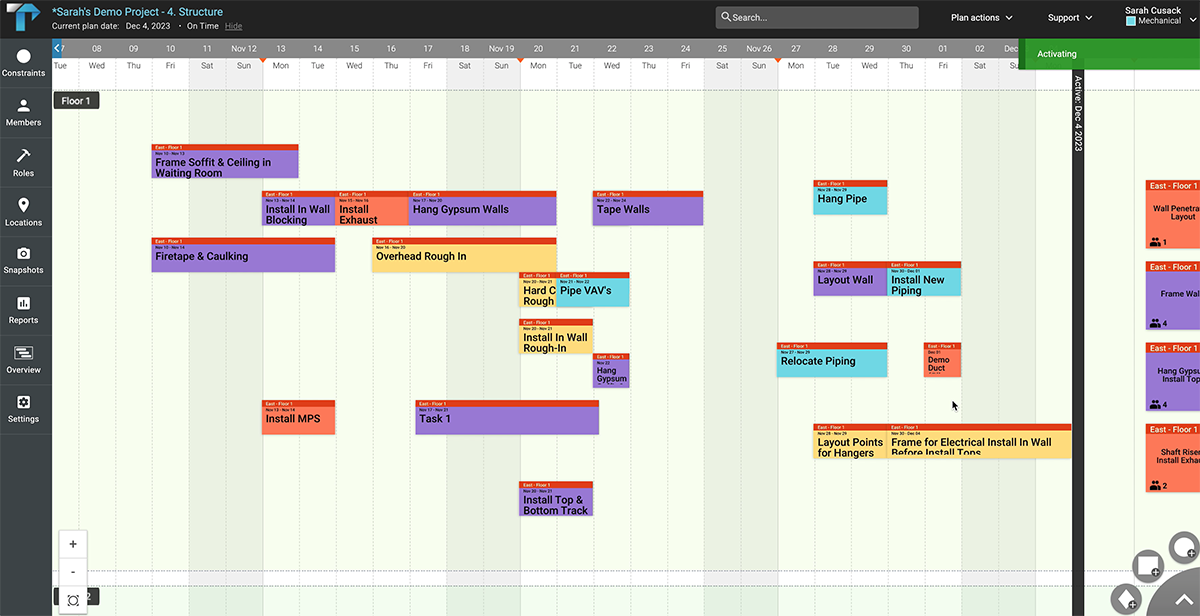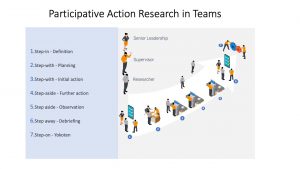Time is money in any construction project, and this is especially true for data center construction. A single delay can cost hundreds of thousands of dollars. Unfortunately, construction productivity has declined since the 1970s due in part to an adherence to command-and-control planning that creates silos between the general contractor and different trade partners.
On the surface, holding trades responsible for finishing on time sounds logical, but finishing on time doesn’t necessarily mean they’ve finished at the right time. What good is it for one trade to finish work when the next one isn’t ready for the handoff? When teams lack a structured cadence to complete activities and allocate resources, the project slows and costly delays ensue.
What’s needed is a new way of planning that focuses on flow, or as the Lean Construction Institute defines it, “a process that includes smooth, unimpeded handoffs between and among project team members from one crew to the next.”
An often underutilized methodology for achieving flow is Takt planning, which creates a rhythm for each phase of work to finish and ensures handoffs occur at the same pace. To make Takt work, you need a construction production management platform to visualize the components necessary to achieve flow.
Where did Takt time originate?
Takt is a German word meaning rhythm, cadence or cycle, and it was originally used to reference timekeeping in music. The implementation of Takt time as a manufacturing concept first appeared in the 1920s with Germany’s Junkers Aircraft Works, which created sub-assembly lines that fed into main assembly lines at predetermined intervals to create consistency and predictability.
By the late 1940s, Toyota had adopted the Takt philosophy for auto manufacturing and based its famous Toyota Production System on Takt time. The methodology eventually found widespread adoption throughout the manufacturing world, and its waste-reduction benefits were popularized in lean manufacturing.
Increasing construction flow with Takt time
While manufacturing accepts Takt time as a standard for production, its popularity within the construction industry hasn’t caught on as it should. As we’ve pointed out, command-and-control is often the go-to philosophy for construction projects, but Takt time makes more sense for data construction projects. Takt time drastically reduces confusion and offers the predictability necessary to ensure on-time project completion.
Takt requires greater collaboration between trades, breaks down traditional silos and prioritizes setting a shared pace for every operation in a sequence. Potential productivity issues are addressed with a visual plan that allows tasks to finish concurrently and encourages easy handoffs between trades for sequential tasks.
Here are some important components of a Takt construction plan:
- Takt phase: Work to be done that is separated into logical groupings based on specific milestones or achievements.
- Takt zone: Geographical areas within the phase where work is scheduled on a rhythm. Trades will move through these zones at the same pace.
- Takt wagon: Grouping of one or more Takt packages or scopes of work.
- Takt package: Manageable units of work within a Takt wagon that can be assigned to a trade for execution within a designated Takt time.
- Takt train: A series of wagons that will move through the zone.
In a data center construction project, zones may be split up like this:
- Zone 1: Data Hall
- Zone 2: Generator Yard
- Zone 3: Substation
- Zone 4: Central Utility Buildings (CUB)
Within each of the zones, it’s critical to identify similar scopes of work that allow for consistent pacing. For example, in a data center construction project, there may be multiple sectors of the Data Hall that are equal to the entirety of another zone. So, the work within those sectors may be broken down to create a consistent amount of work in these predefined areas to ensure consistent pacing.
Once a work cadence is established, trades can work rhythmically through each zone with intentional buffers to allow each team to adjust to unforeseen circumstances and complete work within the Takt time. This level of predictability is critical in data center planning, as it sets expectations early on and creates an environment where productivity is consistent and repeatable, increasing the possibility of on-time completion.
Construction production management software enables better Takt planning
When coupled with the right technology, a Takt data center construction plan can make flow more easily achievable. Let’s look at ways a platform like Touchplan can enhance a solid Takt plan.
Breaking down trade silos
Construction production management software can help bring trades together and encourage collaboration via a platform that visualizes real-time updates. When this data is current, trades have the insight necessary for accurate decisioning and projections. The end result? Takt packages finish in rhythm, and handoffs flow as expected.
Minimizing bottlenecks
Bottlenecks are unavoidable in data center construction, but construction production management software can help you manage them. The right platform visualizes where bottlenecks exist early on and allows decision-makers to address them and keep work moving at the prescribed pace.
Allocating resources accurately
When utilization is at capacity, production, and flow are impeded. As variations within the project increase — fluctuating crew sizes, changes in work, start times, material availability — delays emerge. Construction production management software creates flow and avoids delays by allowing you to visually plan which tasks can be completed concurrently while facilitating seamless handoffs between trades for sequential tasks.
Avoiding or addressing rework
Removing installed work is an immediate flow disruptor. Solutions like Touchplan can assist by integrating the master schedule with the actual workflow and avoiding corrective rework via issues like inaccurate design fulfillment. When unavoidable design changes occur, teams can track rework in real time and incorporate updates into ongoing production to avoid delays.
There’s simply too much at stake in data center construction projects to operate in a manner that inherently limits productivity. With Takt planning and the proper construction production management software, predictability becomes a natural component of the planning process. Watch this webinar to learn how Touchplan can enhance Takt planning initiatives.












